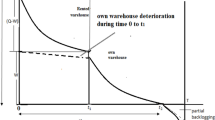Abstract
A disaster inventory system is considered in which two substitutable items are stored for disaster management. In the event of disaster management, a particular product may become stock-out and the situation warrants that a demand for the particular product during its stock-out period may be substituted with another available similar product in the inventory. From the utility point of view, continuous review inventory models are quite appropriate in disaster inventory management. In this paper, a continuous review two substitutable perishable product disaster inventory model is proposed and analyzed. Since the inventory is maintained for disaster management, an adjustable joint reordering policy for replenishment is adopted. There is no lead time and the replenishment is instantaneous. For this model, some measures of system performance are obtained. The stationary behavior of the model is also considered. Numerical examples are also provided to illustrate the results obtained.








Similar content being viewed by others
References
Baron, O., Berman, O., & Perry, D. (2010). Continuous review inventory models for perishable items ordered in batches. Mathematical Methods of Operations Research, 72, 217–247.
Gürler, U., & Özkaya, B. Y. (2008). Analysis of \((s, S)\) policy for perishables with a random shelf life. IIE Transactions, 410, 759–781.
Iannoni, A. P., Morabito, R., & Saydam, C. (2008). A hypercube queueing model embedded into a genetic algorithm for ambulance deployment on highways. Annals of Operations Research, 157(1), 207–224.
Kalpakam, S., & Arivarignan, G. (1988). A continuous review perishable inventory model. Statistics, 19, 389–398.
Kalpakam, S., & Sapna, K. P. (1996). An \((s, S)\) perishable system with arbitrarily distributed lead times. Opsearch, 33, 1–19.
Nahmias, S. (1982). Perishable inventory theory: A review. Operations Research, 30, 680–708.
Nahmias, S. (2010). Mathematical models for perishable inventory control. Wiley Encyclopedia of Operations Research and Management Science. John Wiley & Sons, Inc.
Nahmias, S. (2011). Perishable inventory systems. Series: International series in operations research & management science, Vol. 160. Springer.
Ozdamar, L., Ekinci, E., & Kucukyazici, B. (2004). Emergency logistics planning in natural disasters. Annals of Operations Research, 129, 217–245.
Ozekici, S., & Parlar, M. (1999). Inventory models with unreliable suppliers in a random environment. Annals of Operations Research, 91, 123–136.
Ozguven, E. E., & Ozbay, K. (2014). Emergency inventory management for disasters—A review. Journal of Emergency Management, 12(4), 269–286.
Parlar, M. (1985). Optimal ordering policies for a perishable and substitutable product—A Markov decision-model. INFOR, 23, 182–195.
Parlar, M., Perry, D., & Stadje, W. (2011). FIFO versus LIFO issuing policies for stochastic perishable inventory systems. Methodology and Computing in Applied Probability, 13, 405–417.
Perlman, Y., & Levner, I. (2014). Perishable inventory management in healthcare. Journal of Service Science and Management, 7, 11–17. doi:10.4236/jssm.2014.71002.
Sebastian, H. W. S., Richard, W., Nicky, Y., & Sue, C. (2012). What drives perishable inventory management performance? Lessons learnt from the UK blood supply chain. Supply Chain Management: An International Journal, 17, 107–123.
Srinivasan, S. K.(1974). Stochastic point processes and their applications. London: Griffin.
Yadavalli, V. S. S., van Wyk, E., & Udayabaskaran, S. (2014). A temporo-spatial model for optimal positioning of humanitarian inventories for disaster relief management, accepted for publication and forthcoming in Applied Mathematics & Information Sciences An International Journal. ISSN 1935–0090. http://dx.doi.org/10.12785/amis.
Acknowledgments
The authors are very much grateful to the reviewers for their constructive criticisms and suggestions which improved the content of the paper.
Author information
Authors and Affiliations
Corresponding author
Rights and permissions
About this article
Cite this article
Yadavalli, V.S.S., Sundar, D.K. & Udayabaskaran, S. Two substitutable perishable product disaster inventory systems. Ann Oper Res 233, 517–534 (2015). https://doi.org/10.1007/s10479-014-1783-3
Published:
Issue Date:
DOI: https://doi.org/10.1007/s10479-014-1783-3




